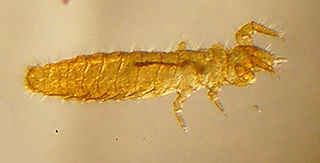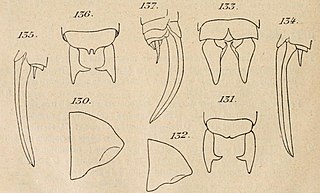
Insects in the family Tettigoniidae are commonly called katydids or bush crickets. They have previously been known as "long-horned grasshoppers". More than 8,000 species are known. Part of the suborder Ensifera, the Tettigoniidae are the only extant (living) family in the superfamily Tettigonioidea.

The Protura, or proturans, and sometimes nicknamed coneheads, are very small, soil-dwelling animals, so inconspicuous they were not noticed until the 20th century. The Protura constitute an order of hexapods that were previously regarded as insects, and sometimes treated as a class in their own right.

Orthoptera is an order of insects that comprises the grasshoppers, locusts, and crickets, including closely related insects, such as the bush crickets or katydids and weta. The order is subdivided into two suborders: Caelifera – grasshoppers, locusts, and close relatives; and Ensifera – crickets and close relatives.

Conocephalus is a genus of bush crickets, known as coneheads. It was described by Carl Peter Thunberg in 1815.

Conocephalus fuscus, the long-winged conehead, is a member of the family Tettigoniidae, the bush-crickets and is distributed through much of Europe and temperate Asia. This bush-cricket is native to the British Isles where it may confused with the short-winged conehead. These two species are phenotypically similar; however, the distinguishing factor between the two is the fully developed set of wings the long-winged conehead possesses that allows for flight. In the short-winged coneheads the hind wings are shorter than the abdomen, causing the wings to be vestigial and the species is incapable of flight. For this reason it is hard to discriminate between the two species during the early stages of their life cycle before the wings have fully developed. The colouration of the conehead is typically a grass green with a distinctive brown stripe down its back, though there are some brown phenotypes.
Andrew Nelson Caudell was an entomologist who specialized in the study of grasshoppers and other insects in the order Orthoptera, becoming a prolific author of taxonomic studies, a member and president of the Entomological Society of Washington, and a fellow of the American Association for the Advancement of Science.

Conocephalinae, meaning "conical head", is an Orthopteran subfamily in the family Tettigoniidae.

Conocephalus gracillimus, the graceful meadow katydid, is a species of meadow katydid in the family Tettigoniidae. It is found in North America.
Conocephalus attenuatus, the long-tailed meadow katydid or lance-tailed meadow katydid, is a species of meadow katydid in the family Tettigoniidae. It is found in North America.

Conocephalus nigropleurum, the black-sided meadow katydid, is a species of meadow katydid in the family Tettigoniidae. It is found in North America.
Conocephalus nemoralis, the woodland meadow katydid, is a species of meadow katydid in the family Tettigoniidae. It is found in North America.

Conocephalus brevipennis, the short-winged meadow katydid, is a species of meadow katydid in the family Tettigoniidae. It is found in North America and the Caribbean.
Liara is an Asian genus of bush crickets in the tribe Agraeciini, belonging to the 'conehead' subfamily Conocephalinae.
Liaromorpha is an Asian genus of bush crickets in the tribe Agraeciini, belonging to the 'conehead' subfamily Conocephalinae. Species records are mostly from Indo-China.

Pseudosubria is an Asian genus of bush crickets in the tribe Agraeciini, belonging to the 'conehead' subfamily Conocephalinae. Species records are from Indo-China and Malesia.
Palaeoagraecia is an Asian genus of bush crickets in the tribe Agraeciini, belonging to the 'conehead' subfamily Conocephalinae. Species have been recorded from Bangladesh, China, Korea, Japan, Indo-China, Malesia, New Guinea and western Pacific islands.
Conanalus is an Asian genus of bush crickets in the tribe Conocephalini, of the 'conehead' subfamily Conocephalinae.

Conocephalus conocephalus is the type species of the conehead genus Conocephalus and the bush cricket tribe Conocephalini. This species has been recorded from southern Europe, including France, and Africa. Described by Carl von Linné in 1767, C. conocephalus appears to have no surviving type specimens, although it is believed that material may have been obtained from Africa.














